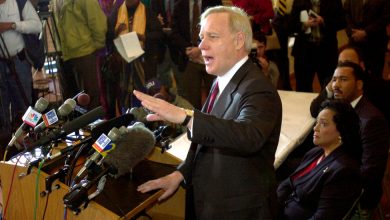Putting the Public Back in Public Service

WASHINGTON — One of the most vexing questions about the dysfunction of Congress is why lawmakers cannot find common ground on big issues facing the country when convincing data suggests there is broad public consensus about what should be done.
Take abortion rights, immigration and guns, three of the most divisive topics of the moment. Polling consistently finds strong majorities backing access to abortion with some limits, permanent legal status for undocumented residents brought to the United States as children and an array of gun control measures including universal background checks. Still, Congress has been tied in knots on the issues for years, with a recent breakthrough on guns falling far short of what public opinion data suggests should be possible.
The reasons are complex, including geographic and cultural differences, the outsized influence of ideological activists in both political parties, the power of lobbyists and the growing polarization of the nation, which has bred disdain for compromise. Some academics and lawmakers believe there may be another reason as well: Members of Congress, they suggest, simply do not have a solid grip on what most of their constituents favor or are willing to accept.
“There is strong evidence that they actually don’t even know the views of their constituents,” said Steven Kull, a psychologist who heads the Program for Public Consultation at the University of Maryland’s School of Public Policy. “They might know the squeaky wheel who shows up at a town hall meeting, but they don’t really know.”
In a new study based on a survey of more than 4,300 registered voters last year, Mr. Kull’s group found that the public’s low opinion of Congress stems at least in part from the impression that lawmakers “have little interest in the views of their constituents, have a poor understanding of the public’s views and do what the majority of Americans would do less than half the time.”
The study, titled The Demand for Public Consultation, found that voters are clamoring for lawmakers to pay more attention but do not see a reliable, consistent way to provide regular guidance to their representatives.
“The process right now is there is no process,” said Gail Hoffman, a consultant to the organization and longtime Washington strategist. “It is just really wild in that it is random who they hear from, and it’s generally organized and often the same people.”
To try to correct that flaw, the Program for Public Consultation, in cooperation with other nonpartisan civic groups and news organizations that publicize the efforts and provide meeting space, has been experimenting with a more structured approach.
In simulations conducted with House members from both parties, representative samples of citizens are solicited and given extensive information on a topic such as immigration or campaign finance and then meet with lawmakers to discuss solutions. The effort also includes a broader poll to assess sentiment in the member’s particular district.
Participants said it was striking, particularly in an era of intense congressional polarization and rampant misinformation, how much agreement they could find on issues that have bedeviled Congress for years.
“What is interesting about this project is it confirms how much consensus on public issues would exist if we all took the time to talk to each other and base our views on careful consideration of the facts rather than tribal partisan messaging,” said Representative Tom Malinowski, Democrat of New Jersey, who took part in a simulation on energy and the environment in March.
The exercise found significant majorities of both Democrats and Republicans in his district backed tax incentives for clean energy and requirements for power companies to use renewable fuels — the type of climate change policies that sharply divide Congress, with Republicans vehemently opposed.
Representative Jamie Raskin, a Maryland Democrat who took part in the exercise a few years ago, said he found a surprising public “convergence” among those participating on campaign and election issues, including backing for a new way to elect members of Congress by ranking favorites, rather than voting for one candidate in a head-to-head contest.
“That emboldened me to become the lead sponsor of the ranked-choice voting bill,” Mr. Raskin said.
The center’s research found overwhelming public support for more extensive voter outreach. Three in four of those surveyed also said that members of Congress should be more responsive to the views of their constituents as a whole, rather than focusing on just those who voted for them.
In another break with partisanship, significant majorities said they would be inclined to support a candidate who committed to putting the views of constituents over the dictates of their party leaders even if they had to cross party lines to do so and differed on legislative approaches.
“Even among those who disagreed with half of the positions they were presented, majorities said they would nonetheless likely vote for a candidate committed to public consultation,” the report says.
The findings were based on theoretical situations, and the views of voters could of course change in real-world circumstances. But authors of the study said it was evident that politicians could reap political rewards by embracing greater consultation and less partisanship.
“Among the public, it is really quite clear,” Mr. Kull said. “They want their representatives to consult them.”
Under the center’s vision, interested lawmakers would take a formal pledge committing to public communication. The pledge used in the simulation said the lawmaker recognized that “this country was founded on the idea that elected officials should listen closely to the people” and that they committed to “consult with my constituents on major issues before Congress and to take their views into account when deciding how to vote.”
Through polling and other research, a special “citizens cabinet” of several hundred representative constituents would be established. Using online tools, the panels would be briefed on major policy questions, given pro and con arguments and asked to make recommendations. Lawmakers would not be obligated to vote in line with the majority recommendations but would be expected to explain their rationale if they did not.
Whether such an approach is too unwieldy or at all workable in the current maelstrom of politics and governance by crisis, when lawmakers spend more time talking to donors than voters, remains to be seen. The “squeaky wheel” who dominates town halls may also be more likely to vote in a party primary, and lawmakers know that if they fail to appeal to those constituents, they are unlikely to survive in Congress long enough to do any legislating, well-informed or otherwise.
But supporters say their research has shown the approach can work, and they are hoping to take it beyond the prototype stage.
Mr. Raskin said that while the citizen panels might not be a panacea, “at this point, I will try anything. I like the idea of a randomly drawn cross-section of a district that would operate kind of like a citizen legislative jury.”
The goal now is to get Congress involved, perhaps with an institute to foster such citizen panels, or at minimum create the capacity for members who want to engage with their voters on a deeper level to be able to do so. If Congress itself is slow to respond, backers of the idea intend to push forward and involve more lawmakers to try to elevate the concept.
“We are going to be going into more and more states and congressional districts and doing these things, partnering with local media,” said Ms. Hoffman. “If government isn’t ready to act, we can be on the outside pushing in. We are moving forward to insert the people into the process.”



